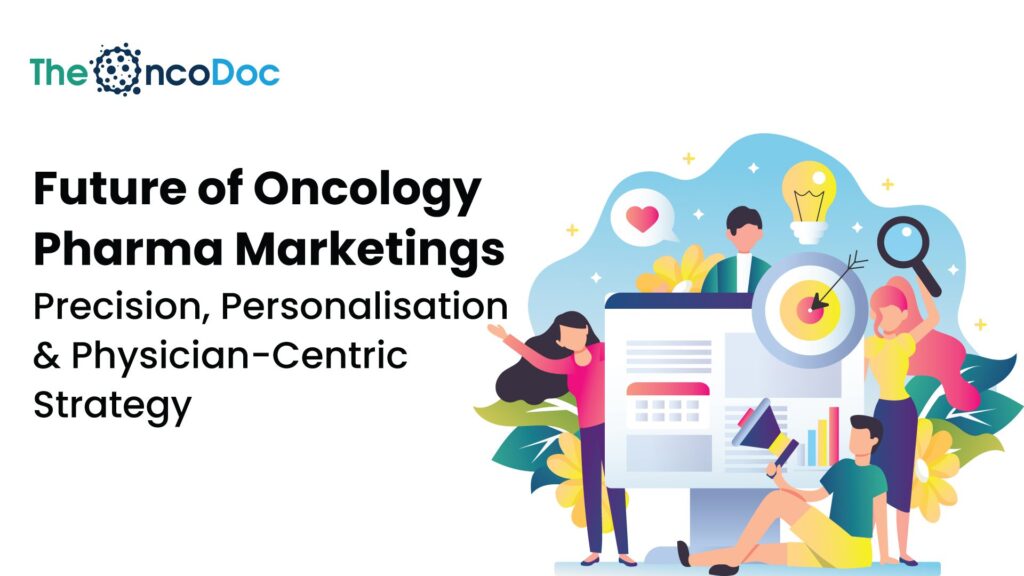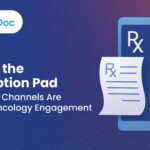Introduction: The Oncology Marketing Evolution
As the global oncology market expands at an unprecedented rate, expected to reach over $581 billion by 2030, pharmaceutical marketers are faced with both a golden opportunity and a steep challenge. The traditional marketing playbook, built around reps, conferences, and journal ads, is no longer sufficient. Oncologists today are digital-native professionals managing increasingly complex patient journeys. They demand relevant, timely, and trustworthy information delivered across the right touchpoints.
In this new era, pharma marketing is evolving into a physician-centric model, combining data science, clinical relevance, and hyper-personalised content to influence behaviour and support better decision-making.
This article explores how pharmaceutical companies can optimise their marketing strategies for oncologists by using data-driven insights, digital ecosystems, co-creation, and ethical communication, leading to improved engagement and, ultimately, better patient outcomes.
The Changing Needs of the Oncology Community
Oncologists operate in a high-pressure ecosystem marked by rapid drug innovation, complex diagnostic criteria, and evolving treatment guidelines. While access to information is greater than ever, content saturation, conflicting recommendations, and limited time hinder informed decision-making.
Key Pain Points for Oncologists:
- Information Overload: Over 10,000 clinical trials are underway in oncology at any given time.
- Time Constraints: Physicians have less than 2 minutes on average to explore non-clinical content.
- Demand for Relevance: Local guidelines, patient demographics, and hospital protocols shape clinical priorities.
- Scepticism Toward Marketing: Any sign of biased or aggressive promotion can lead to disengagement.
Understanding these constraints is crucial for marketers looking to build trust, deliver value, and drive outcomes.
Core Pillars of Effective Oncology Pharma Marketing
1. Hyper-Personalisation in Oncology Communication
The era of static email campaigns and generic content is over. Leading pharmaceutical companies now use AI-powered engines to tailor communication based on:
- Subspecialty focus (e.g., triple-negative breast cancer, AML)
- Content engagement history (e.g., prefers video over text)
- Language preference and geographic region
- Conference attendance or CME completions
Examples of Hyper-Personalisation:
- A GI oncologist receives a microsite curated with ESMO colorectal trial summaries.
- A thoracic specialist gets a mobile push notification with a short explainer on KRAS G12C inhibitor resistance mechanisms.
This personalisation leads to higher relevance, deeper engagement, and improved clinical recall.
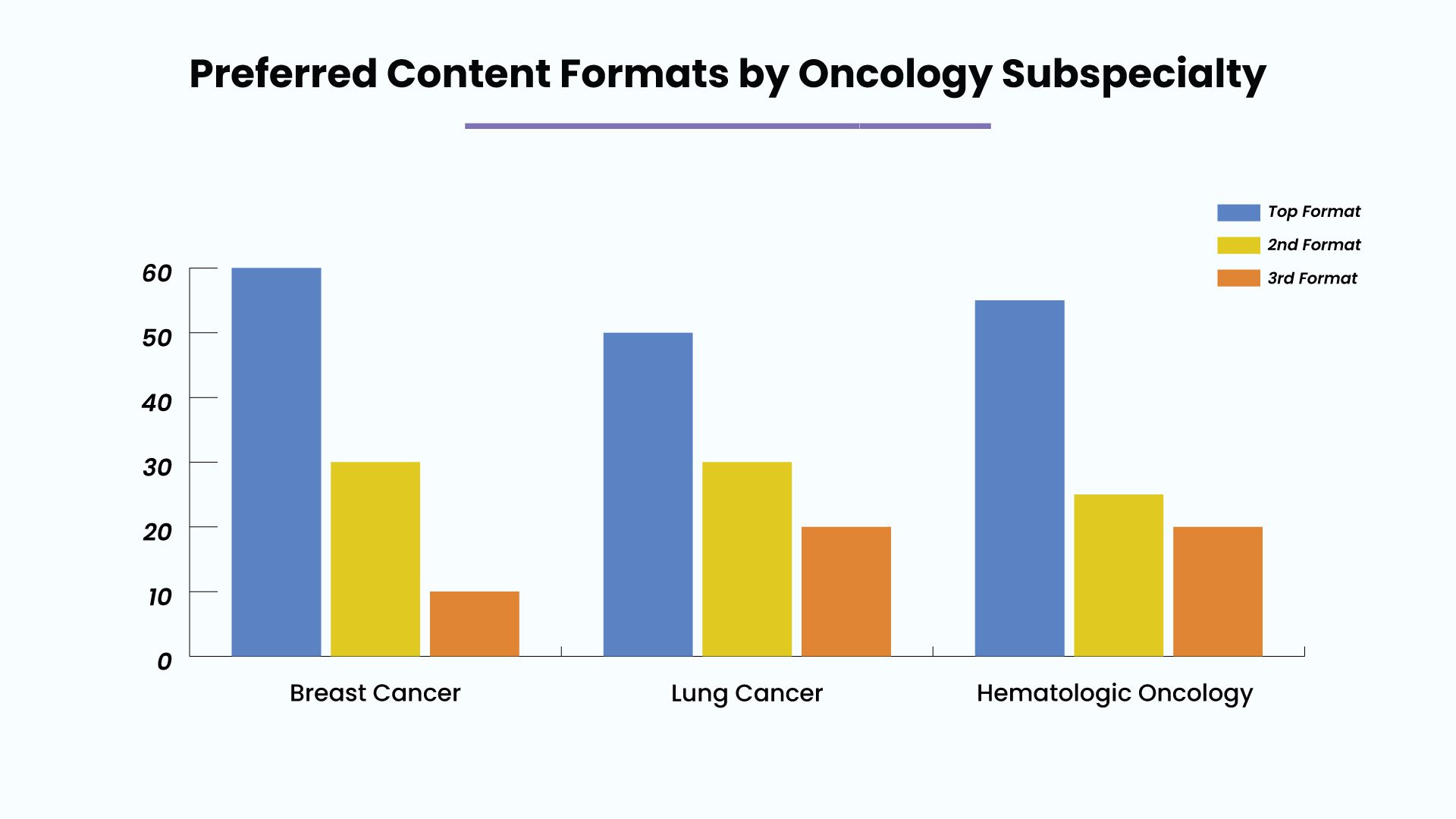
2. Multichannel Engagement: The Omnichannel Imperative
Today’s oncologists navigate across multiple platforms, LinkedIn for professional connections, YouTube for quick explainers, and peer groups like Telegram for real-world case discussions. To stay relevant, pharma brands must be present across:
- Email (personalised alerts, summaries)
- Rep Detailing (via Veeva, Salesforce)
- CME platforms (Medscape, UpToDate)
- Closed peer networks (e.g., Sermo, Hidoc Dr.)
📈 Data Insight:
Brands that employ 3+ digital touchpoints show a 47% higher engagement rate compared to single-channel campaigns.
Success lies in orchestrating consistent, non-intrusive messaging across the user’s preferred journey.
3. Predictive Analytics & Behavioral Segmentation
Predictive analytics allows marketers to move from content blasting to anticipatory engagement. By mapping:
- Prior viewing behavior
- Therapy area interest
- Device and access patterns
- Preferred engagement times
…brands can time and format content for maximum relevance.
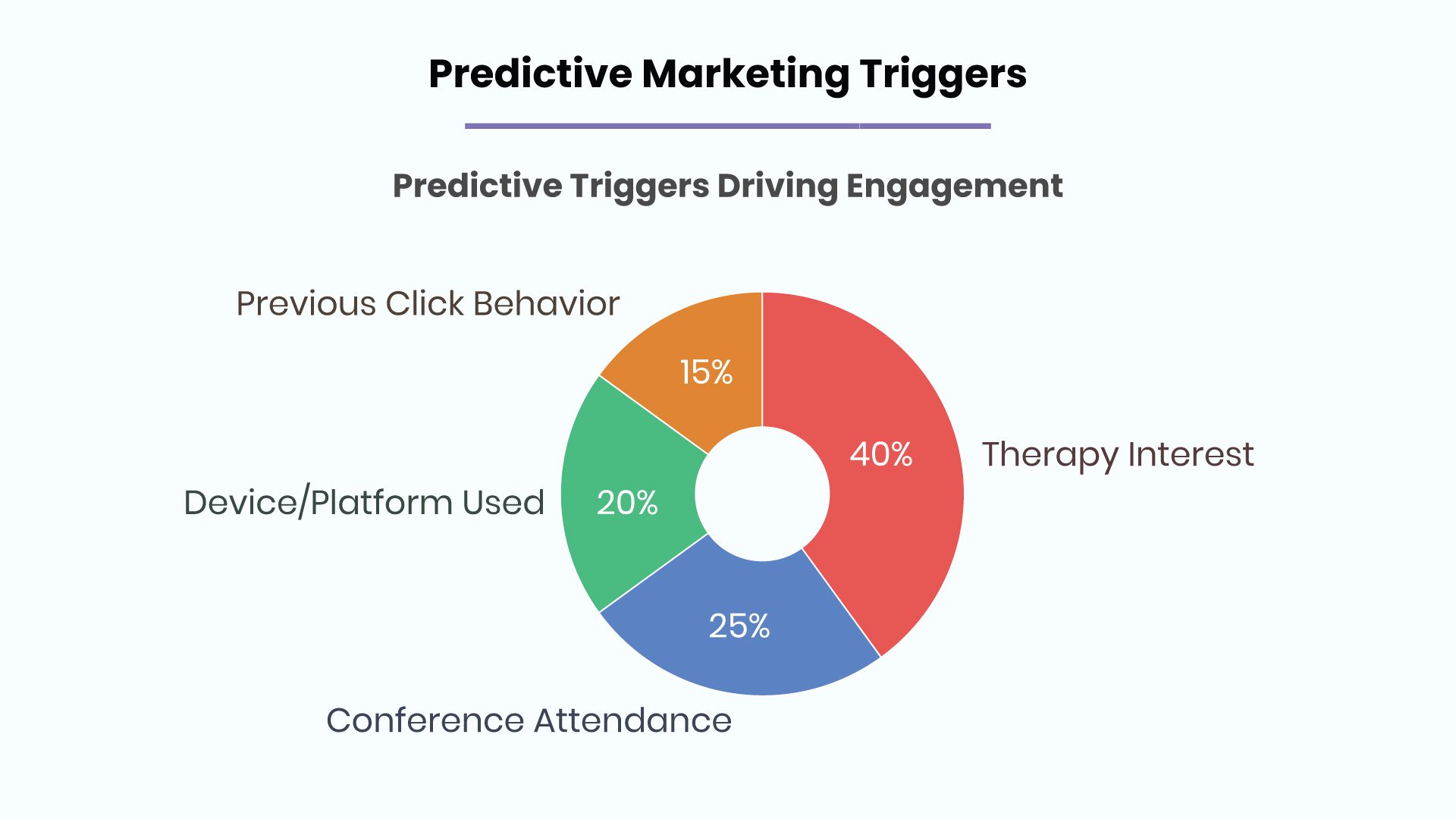
The shift from static to dynamic engagement transforms pharma from a passive provider to a trusted decision-support partner.
Co-Creation with Digital Onco-Leaders
Oncologists now trust their peers more than traditional pharma authorities. Brands that engage with emerging digital KOLs and foster collaborative content development see better results.
Co-Creation Models:
- Peer-led treatment decision trees
- Joint webinars or podcast series
- Infographics summarizing ASCO/ESMO updates
- Rebuttals to trending clinical controversies
These formats not only drive credibility but also improve discoverability via social sharing and peer-to-peer distribution.
Micro-Communities: Peer Networks That Drive Decisions
Many treatment decisions are influenced informally through WhatsApp discussions, Telegram groups, or closed Discord servers. These are the modern tumor boards.
Pharma can engage ethically by:
- Sharing open-access patient checklists
- Hosting guideline refresher polls
Offering CME-linked case discussions
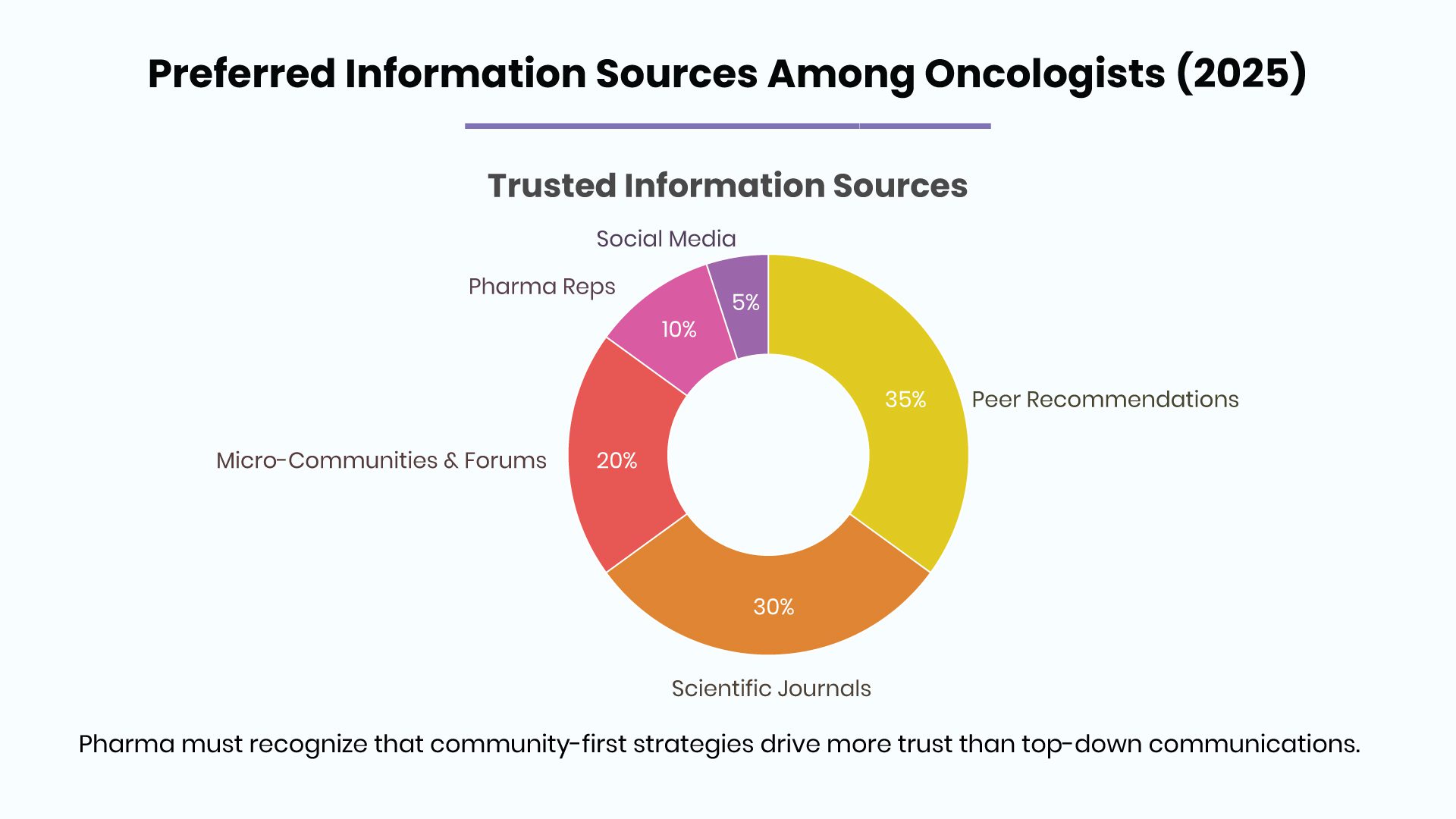
Pharma must recognize that community-first strategies drive more trust than top-down communications.
Localizing Oncology Content Across Regions
Oncology care is heavily influenced by local:
- Reimbursement structures
- Drug accessibility
- Cultural attitudes toward end-of-life care
For example:
- Indian oncologists may prioritize oral therapies due to outpatient constraints.
- German specialists may seek biosimilar efficacy studies due to payer mandates.
Localization Success Checklist:
✅ Translate scientific content
✅ Reference regional KOLs
✅ Align with local guidelines (e.g., NICE, NCCN, ICMR)
✅ Adjust for platform behavior (e.g., WhatsApp vs LinkedIn)
Integration of Reps with Digital Tools
Pharma reps remain relevant, but only when augmented with digital intelligence. Armed with engagement insights, reps can:
- Share the right clinical aid based on prior views
- Invite doctors to webinars aligned with their interest areas
- Schedule follow-ups post-video or content exposure
Reps backed by analytics show 24% higher meeting closure rates and improved brand sentiment.
Real-World Evidence (RWE) Integration in Marketing Content
In oncology, clinical trial data often doesn’t capture the full spectrum of patient experiences seen in everyday practice. That’s where Real-World Evidence (RWE) plays a critical role. By incorporating RWE, such as outcomes from electronic health records, insurance claims, and patient registries, pharma marketers can create content that is more relevant, practical, and reflective of actual clinical settings.
For example, showcasing how a new immunotherapy performs in elderly patients with comorbidities outside of controlled trials can help oncologists make more informed treatment choices. RWE-backed messaging also strengthens clinical credibility, especially when used to demonstrate comparative safety, real-world survival rates, or patient quality of life.
Patient-Centric Messaging for HCPs
Modern oncology marketing is shifting from product-centric to patient-centric storytelling. Oncologists want to know more than just PFS (progression-free survival) or OS (overall survival), they want to understand how a treatment affects a patient’s daily life.
Incorporating patient-reported outcomes (PROs), case stories, and real-life benefits like improved mobility or reduced hospital visits makes your messaging more empathetic and relevant. For example, showcasing how an oral chemotherapy helped a young patient maintain work-life balance or minimized travel time for treatment can deeply resonate with HCPs concerned about holistic patient care.
This approach not only humanizes your brand but aligns with the oncologist’s mission: improving patient lives, not just treating cancer.
Dynamic Content Hubs Instead of Static Pages
Traditional marketing assets like static PDFs or one-size-fits-all web pages are being replaced by dynamic content hubs, interactive, modular platforms tailored to an oncologist’s interests and behavior. These hubs automatically adjust featured content based on previous interactions, such as therapy focus, preferred format, or time of engagement.
For example, if an oncologist frequently views content on colorectal cancer and favors short videos, the platform prioritizes similar materials in future visits. This level of customization enhances engagement, supports continuous learning, and builds long-term content journeys rather than isolated touchpoints, making the pharma brand a go-to resource, not just a supplier.
Engagement Scoring for Better Targeting
To refine outreach, pharma marketers are increasingly adopting engagement scoring models. These systems assign scores to oncologists based on their interactions, such as clicks, downloads, webinar participation, and rep meeting requests.
Higher engagement scores indicate warmer leads or more interested clinicians, allowing marketers to:
- Prioritize follow-ups
- Offer exclusive or advanced-level content
- Route high-engagement HCPs to MSLs or KOL programs
This data-driven approach shifts marketing from a broad strategy to a precision targeting model, ensuring resources are focused on the most receptive and influential oncologists.
Emotional Intelligence in Oncology Marketing
While most pharma strategies focus on clinical data, the emotional state of oncologists plays a critical role in message receptiveness.
Oncologists face emotional fatigue, high patient mortality, and ethical dilemmas daily. Pharma content that:
- Acknowledges the emotional complexity of care
- Offers patient education tools
- Provides mental health resources for clinicians
…will stand out as truly empathetic and valuable.
Metrics That Matter: Impact, Not Impressions
The old KPIs, clicks, views, and likes fail to capture real-world influence. New-age success metrics include:
- Rep follow-up rate post content exposure
- Guideline integration into hospital protocols
- Diagnostic tool usage among targeted HCPs
- Therapy initiation frequency by market
Success is no longer about vanity, it’s about value.
Spotlight: Precision Campaign in Lung Cancer
A leading pharma company used AI to drive education for NSCLC oncologists in Tier-2 cities. It used:
- Interactive biomarkers tool
- Region-specific trial updates
- Predictive time scheduling
Results:
- +64% rise in MSL consults
- +45% surge in biomarker test adoption
- Higher engagement from under-targeted regions
Global Oncology Markets: Custom Approaches
Pharma marketing must evolve by region maturity and digital behaviour:
| Region | Strategy Focus | Key Platform |
| US | Data-rich omnichannel | Medscape, LinkedIn |
| EU | Compliance-driven personalisation | Email, Conferences |
| LATAM | Mobile-first education | WhatsApp, Telegram |
| Asia-Pacific | Regional KOL validation | YouTube, Webinars |
| MENA | Arabic local-language content | PDF briefs, Rep visits |
Future Trends in Oncology Pharma Marketing
1. Generative AI Medical Advisors
AI chatbots that assist oncologists with trial comparisons or dose adjustments in real-time.
2. HCP NFTs and Blockchain CME
Tokenised achievements for attending educational events, redeemable for diagnostics or tools.
3. Emotional Sentiment Dashboards
Real-time tracking of emotional feedback from oncology communities to adjust messaging tone.
4. Geo-Fencing for Onco Events
Delivering location-based mobile alerts during regional oncology congresses.
Conclusion: A Relationship-Driven, Data-Smart Future
The future of pharma marketing in oncology is deeply human and profoundly digital. It is rooted in empathy, fueled by data, and measured by clinical relevance.
For brands to succeed, they must:
- Anticipate needs using predictive tools
- Earn trust through ethical personalisation
- Educate via peer-led content
- Adapt across regional behaviours
- Embrace outcome-based KPIs
In this new era, pharma marketers are no longer storytellers, they’re enablers of science, empathy, and impact.
The Oncodoc team is a group of passionate healthcare and marketing professionals dedicated to delivering accurate, engaging, and impactful content. With expertise across medical research, digital strategy, and clinical communication, the team focuses on empowering healthcare professionals and patients alike. Through evidence-based insights and innovative storytelling, Hidoc aims to bridge the gap between medicine and digital engagement, promoting wellness and informed decision-making.

